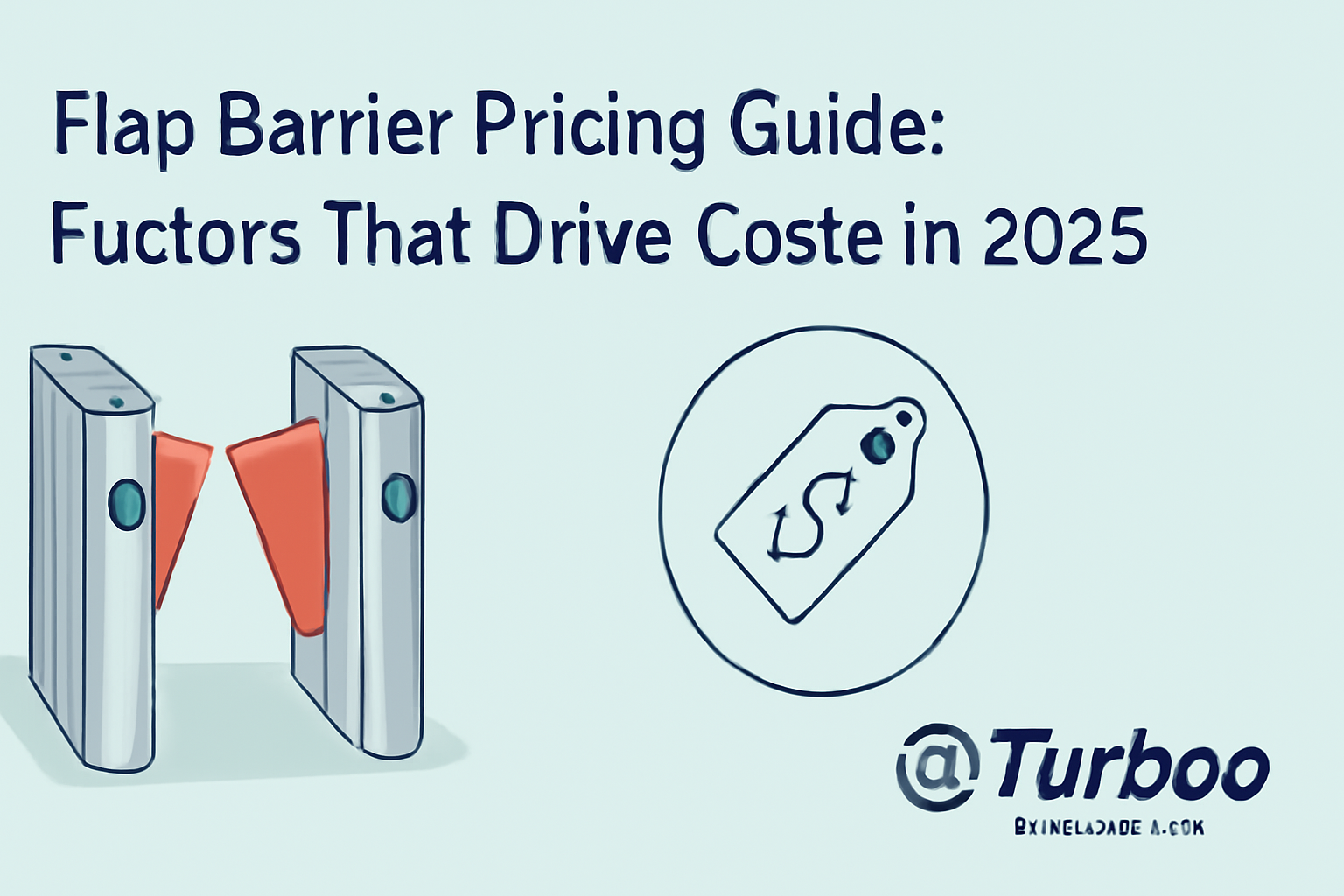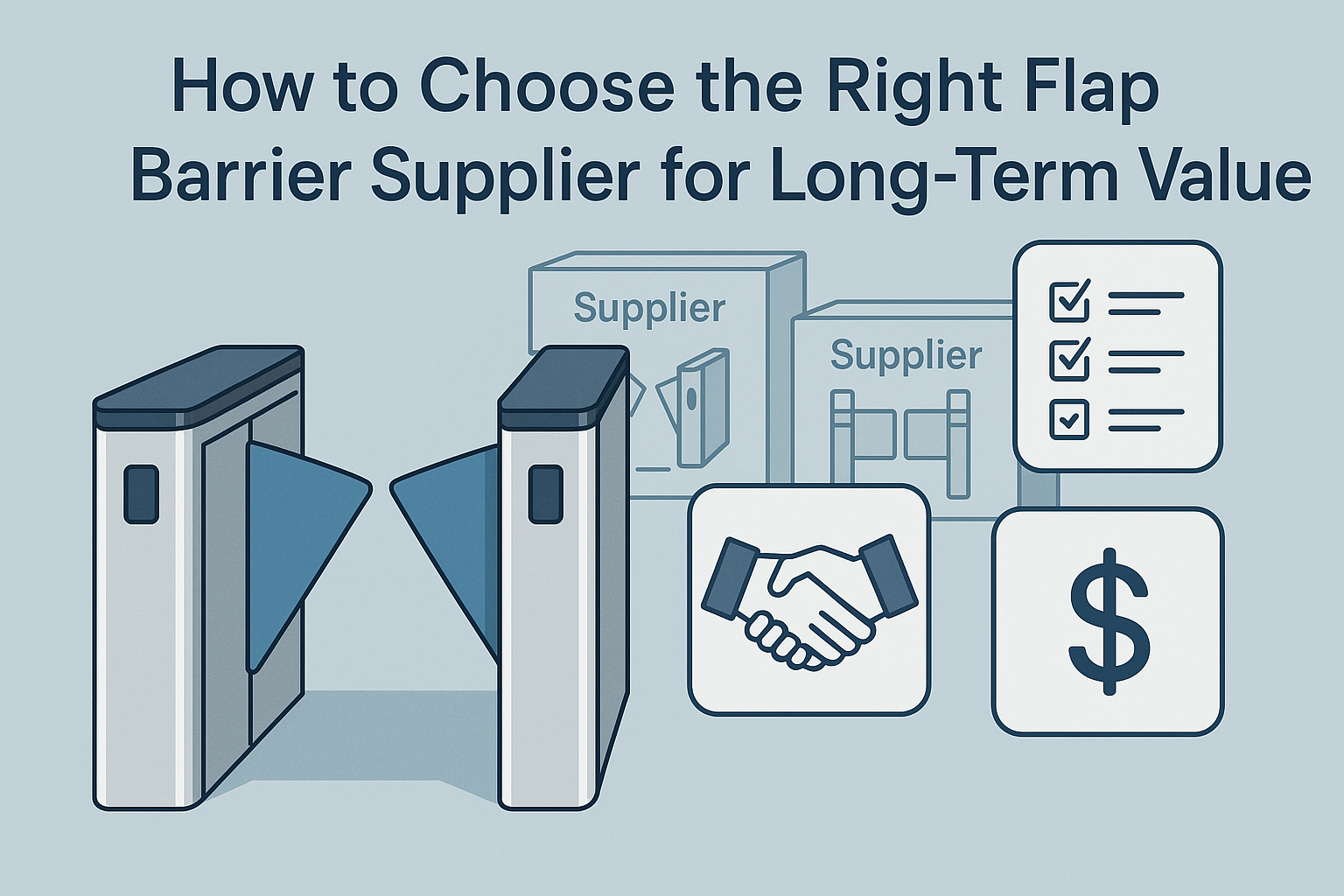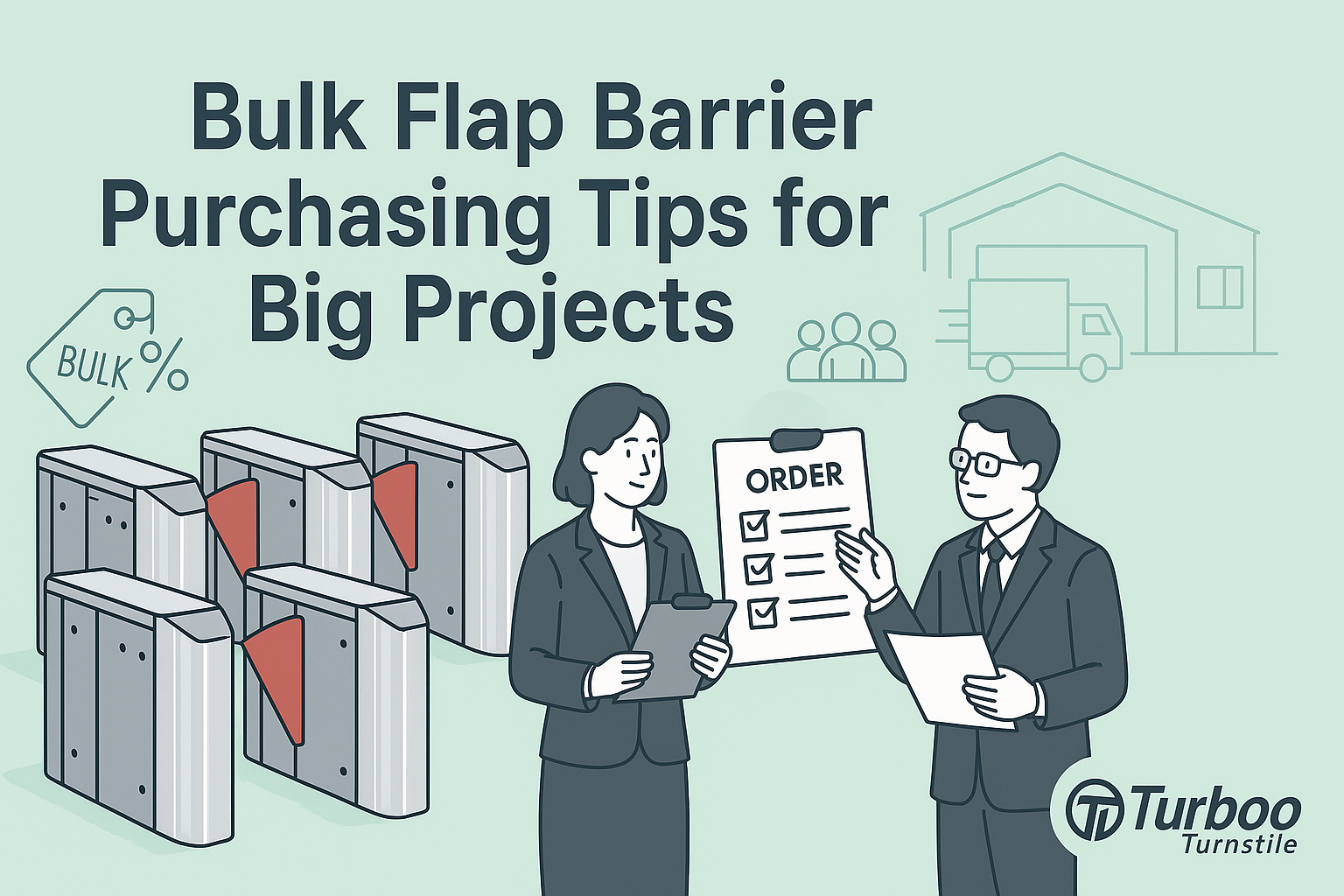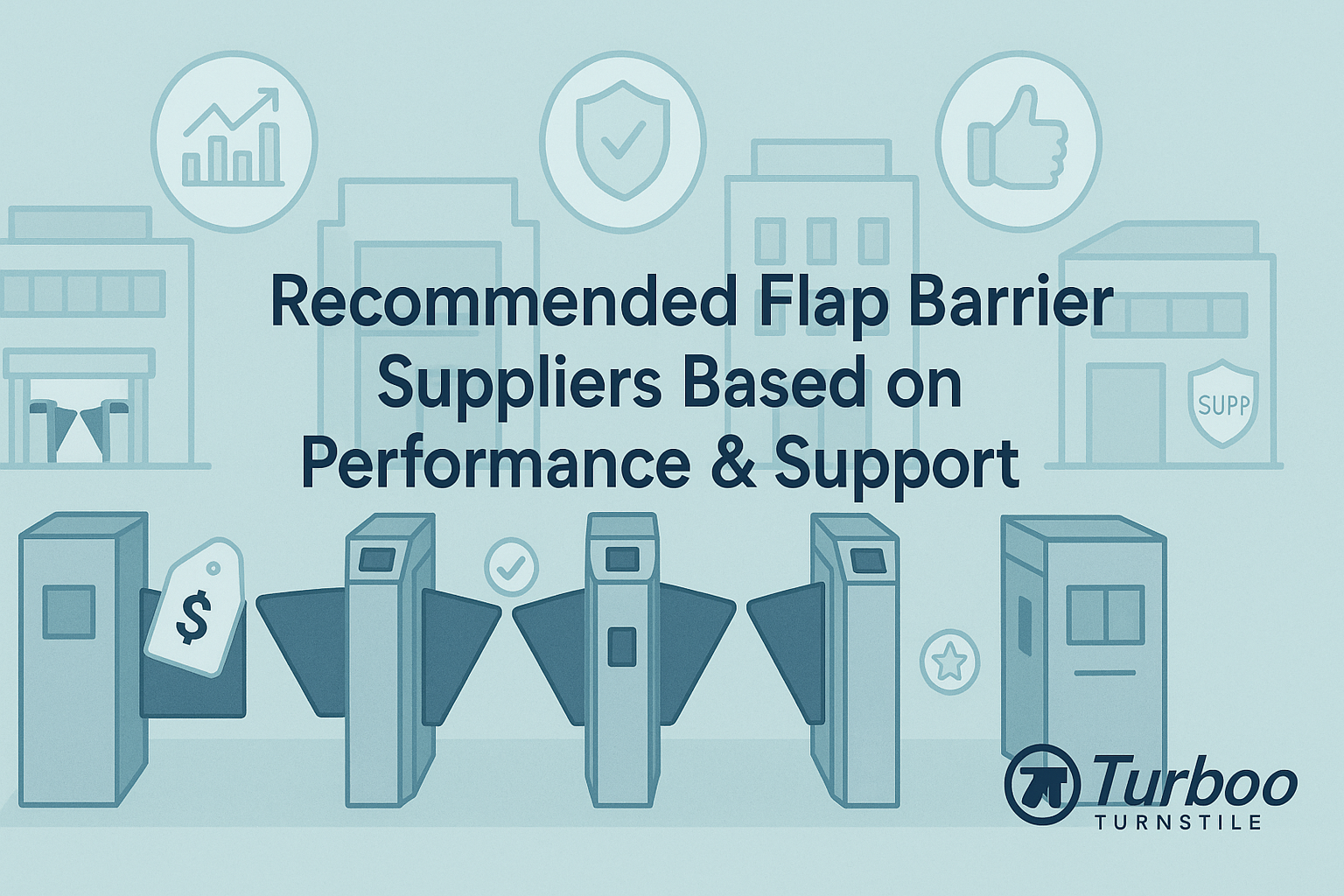Flap Barrier Pricing Guide: Factors That Drive Costs in 2025


Facility managers often face a confusing price range when sourcing flap barriers. One model might be listed at $900, while another shows $2,300 for what seems to be the same thing. That gap leaves decision-makers wondering: what exactly am I paying for?
In 2025, pricing for flap barriers is changing fast. Technology is evolving, safety regulations are tightening, and new features are being added. Some suppliers include advanced software, while others sell basic models with optional upgrades. That’s why one system might seem cheap until you factor in licensing fees, integration costs, or installation complications.
This flap barrier pricing guide aims to cut through the confusion. It shows what truly drives cost in 2025—from material quality to software layers to the impact of international certifications. If you’re planning your budget or comparing quotes, this guide will help you understand what you’re really paying for.
Instead of focusing on the lowest number on a price sheet, you’ll walk away with a smarter approach—knowing where to spend, where to save, and how to match your needs with the right solution.
Let’s dive into the key entry system pricing factors shaping today’s market.
Material Quality and Cost Impact
Material selection is one of the most visible and foundational cost drivers in flap barrier pricing. The type of material used in the barrier’s frame, housing, and internal components has a big impact on durability, maintenance, and long-term value.
Stainless steel is a common choice, especially in mid-range and high-end models. It offers excellent resistance to corrosion, scratches, and environmental wear. Models using 304 or 316-grade stainless steel tend to cost more upfront, but they last longer, especially in outdoor or high-use environments.
Cheaper barriers may use powder-coated alloys or thin-gauge metals. These materials bring the initial price down, but they also wear out faster. Paint may chip. Rust can form. And once the exterior deteriorates, so does the perception of security and professionalism.
Internally, the use of plastic vs. aluminum parts can also affect the pricing. Cheaper plastics might crack under heavy use, requiring frequent replacements. While a more robust alloy setup might raise the initial cost, it reduces total service needs down the road.
Flap barrier pricing guides always start with materials for a reason—they’re the base layer of every other cost.
Design and Finish Upgrades
Today’s entry points are more than just functional—they’re part of a building’s image. That’s why design has become a major cost factor. Custom finishes, colored lighting, and sleek glass arms raise the price of flap barriers, but they also serve specific needs.
Offices, banks, and hotels often want flap barriers that match interior aesthetics. A basic steel finish might be fine in a factory or a train station, but it won’t suit a luxury corporate lobby. Barriers with brushed metal panels, tempered glass inserts, or integrated LED lights are priced higher because of the materials and manufacturing precision required.
Another driver is design complexity. Some units come with low-profile cabinets and rounded corners, giving them a sleek, modern look. Others offer branding options like embedded logos or digital displays. These enhancements boost the visual appeal—but they also increase engineering and production costs.
Even small upgrades, like soft-edge arm movement or noise-dampening design, can bump up the price. But they improve the user experience, especially in quiet environments.
So if you’re comparing two barriers that look different but perform similarly, it’s likely that the design details are contributing to the cost difference.
Speed and Throughput Features
Flap barrier speed isn’t just about faster opening times. It directly impacts how many people can pass through in a given minute, and that throughput capability can drive costs upward—especially in places with high foot traffic.
Entry points like metro stations or airports can’t afford delays. They need barriers that open and close within seconds, detect users instantly, and reset rapidly to handle the next entry. Barriers designed for this kind of speed use better motors, smarter sensors, and tighter calibration—all of which add to the manufacturing cost.
Low-cost models may operate at slower speeds or lag when sensors misread a user. That doesn’t just inconvenience people—it causes crowding, manual overrides, and staff intervention. A high-speed model solves those problems but comes with a higher base price.
The throughput rating—often measured in users per minute—is an essential benchmark in a flap barrier pricing guide. If a barrier handles 25 people per minute versus 40, there’s likely a technical reason tied to both motor strength and processing software. And stronger motors cost more.
Choosing the right speed level for your site ensures you’re not under-buying for peak hours or overpaying for performance you don’t need.
Smart Software Features and Licensing
Modern flap barriers do more than open and close. They’re increasingly connected to central management systems, cloud platforms, and real-time monitoring software. These digital features add convenience and improve security, but they also raise the price—especially when software licensing is involved.
Basic models may include a local control panel with manual settings. But mid- and high-end barriers come equipped with access to advanced dashboards. These allow facilities to track usage, manage remote access, set schedules, and receive error alerts. If the software is proprietary, there may be an annual licensing fee or one-time activation cost.
Another pricing factor is API integration. If your flap barrier needs to connect with custom databases or advanced access control networks, the software must support open protocols or come with developer tools. Those capabilities often come at a premium.
In 2025, more suppliers are offering remote diagnostics and firmware updates through secure cloud platforms. While convenient, these features usually carry extra charges. The price may include encrypted communication channels, service subscriptions, or storage fees for access logs.
When reviewing entry system pricing factors, always ask about software terms. Some buyers are surprised to find out their system won’t work fully without activating or renewing a software license.
So while the physical barrier may look the same, the software behind it can quietly shape both functionality and final cost.
Security and Safety Technology
Safety features are another major component shaping barrier cost in 2025. The more advanced the tech, the higher the price—but also the greater the protection.
Sensors prevent accidents and detect intrusions. In cheaper models, you might get basic infrared beams to detect movement. In advanced systems, the sensor grid is more precise, detecting tailgating, forced entry attempts, and wrong-way movement. These upgrades require better processing units and more sensors, which raise the cost.
Some systems also include built-in anti-climb protection. If someone tries to jump the barrier, the system triggers an alarm. Features like this aren’t always obvious in marketing specs, but they can be crucial in high-security settings.
Biometric authentication—such as facial recognition or fingerprint scanning—is becoming more common in 2025. This adds cost through specialized readers and software. Similarly, QR code readers and RFID modules increase the price depending on how advanced or fast the reading mechanism is.
Each additional layer of safety adds to the price tag. But in locations where safety and monitoring are non-negotiable, these tech add-ons aren’t luxuries—they’re requirements.
To understand broader trends in security tech pricing, refer to Security Info Watch.
Integration Needs with Other Systems
Many facilities already have access control systems in place. When buying a flap barrier, integration compatibility becomes essential—and it affects price.
If your current access solution uses HID cards or biometric terminals, the barrier must support those inputs. That might require additional modules, converters, or software APIs. The more adaptable a flap barrier is, the more it may cost—but it also saves time and money during setup.
Some barriers are “plug-and-play” with major access systems. Others need customization or manual configuration. The cost of these adjustments varies, but they usually require tech support hours and sometimes added hardware.
Think also about future integrations. If you’re planning to add mobile access or migrate to cloud-based management later, choose a model that supports those changes. Barriers that offer future-ready ports and network capabilities often come at a premium, but the long-term savings are real.
In short, integration needs might not be a visible barrier cost driver—but they directly affect installation ease, scalability, and upgrade costs.
Brand Reputation and Support Quality
Not all flap barriers are made equal—and brand name can be a major clue. Known brands tend to cost more upfront, but they often come with better warranties, faster support, and higher component quality.
A reliable brand usually offers longer service life, more precise engineering, and easier access to spare parts. These aren’t just soft benefits—they translate into fewer outages, reduced maintenance fees, and smoother operation.
Support also plays a big role. If a supplier has local offices, regional partners, or 24/7 help desks, they’re better prepared to assist you post-installation. That support network affects pricing. A company that offers remote diagnostics or in-person setup assistance usually includes those services in the sale price or bundles them into extended warranty plans.
In contrast, a cheaper or unknown brand may offer a tempting price—but without strong backup, problems can become costly and hard to fix. You could end up spending more over time just trying to get the system working again.
So while brand value isn’t always easy to measure, it’s deeply tied to both performance and pricing in today’s market.
Installation Requirements and Site Prep
One of the most overlooked costs in any flap barrier setup is installation. It’s not as simple as placing the unit and plugging it in. Many barriers need floor mounting, power wiring, network setup, and integration with door control systems.
If your site isn’t prepped, you might need construction changes like concrete cutting, cable rerouting, or additional electrical lines. Some units require under-floor wiring and power management, which adds complexity.
Also, the labor cost depends on the type of barrier. Heavier or more complex units take longer to install and require more manpower. If the supplier doesn’t include installation, you’ll need to hire a technician familiar with the system, which might mean a premium service rate.
Some locations, especially government or data-sensitive sites, require specific security clearances or background checks for installers. These can also raise the cost of setup.
Installation isn’t just a one-time event. Sites often require testing, calibration, and training. Those service hours contribute to total cost, even if they’re listed separately.
Smart buyers factor installation into the total price—and look for systems that match their current infrastructure to minimize site prep costs.
Certification and Compliance Costs
Compliance is becoming a bigger part of flap barrier pricing in 2025. Many facilities—especially those in regulated industries—can’t install just any model. They need barriers that meet specific certifications. These might include CE marks for European markets, ISO standards for manufacturing quality, or UL listings for safety in North America.
These certifications take time and money for manufacturers to obtain. That cost is passed along to the buyer. For example, a CE-certified flap barrier has gone through electromagnetic compatibility testing and safety analysis. That extra validation adds to production time and material specs, which raises the price.
Different markets have different standards. A flap barrier designed for hospitals or airports may need ADA compliance for accessibility. That could involve changes to width, movement sensitivity, or emergency override behavior. All of these tweaks, while subtle, influence cost.
It’s easy to ignore certification during price comparisons. But if you buy a non-compliant unit, you may face regulatory issues or even be forced to replace it. Worse, a failed inspection or denied insurance claim could lead to bigger financial losses.
Buyers should always match their compliance requirements with the product documentation—and understand that meeting those standards affects the pricing from the ground up.
Green Materials and Eco-Friendly Designs
As environmental regulations tighten and sustainability becomes a bigger focus in construction and infrastructure, many facilities now prefer flap barriers made with eco-friendly designs. These options cost more upfront but offer savings or benefits over time.
Green design starts with the materials. Some manufacturers use recycled aluminum or stainless steel, which costs more to process but reduces the environmental footprint. Low-VOC paints and non-toxic coatings are also more expensive but safer for enclosed environments.
Another aspect is energy efficiency. Barriers designed with low-power motors or intelligent standby modes use less electricity. This might mean a more complex circuit design, which adds cost—but for many buyers, the long-term energy savings and eco-branding justify the higher price.
In 2025, some procurement bids now include sustainability scoring. A model that meets environmental benchmarks may win out over a cheaper unit simply because it aligns with green building goals. That makes green features not only a cost driver—but also a competitive advantage.
If your facility is aiming for LEED certification or carbon reduction goals, these pricing elements are worth every dollar.
2025 Pricing Trends in Flap Barriers
This year, several trends are shaping how flap barriers are priced. One of the biggest shifts is the increased demand for smart systems. Facilities want more control, more data, and more flexibility—which means more software, more sensors, and higher hardware specs.
The cost of microchips and circuit components also remains high due to ongoing supply chain issues. That affects mid- and high-end units most, since they rely on complex electronics for things like biometric access or automated logging.
Safety demands are rising too. In part due to global regulations, and in part due to buyer expectations, many flap barriers now come standard with safety sensors, anti-intrusion systems, and touch-free entry options. These features used to be premium—now they’re baseline, and that shift has pushed pricing up overall.
Also, there’s more attention on visual design. Buyers are requesting sleeker finishes, integrated lighting, and branding elements that once were considered “custom” but are now standard in high-end office and public venues.
To explore market research on pricing trends, see this source: Markets and Markets – Pricing Trends
In short, flap barrier pricing in 2025 is rising—but it’s also delivering more value per dollar if you know what to look for.
Global Supply Chain and Pricing Volatility
Global events continue to shape the pricing landscape. From raw material shortages to freight cost spikes, supply chain volatility is directly impacting flap barrier production and delivery prices.
Stainless steel prices have fluctuated sharply over the past year. When a manufacturer locks in steel pricing during a lull, they can offer more stable barrier costs. But when material costs rise mid-production, those hikes are passed to buyers.
Shipping delays and port congestion also affect timelines. Some suppliers stock barriers locally to reduce wait times, but that inventory comes at a cost. Others import based on demand, which may lead to sudden price jumps depending on fuel costs or currency shifts.
In 2025, import duties and region-specific taxes have also grown in certain markets. Buyers in South Asia, for instance, may pay more due to new tariffs on electronics. This can make the same model cost 15–20% more depending on where it’s purchased.
Buyers should always ask suppliers how pricing is calculated—and whether it includes shipping, taxes, and installation. These extras can significantly alter the real purchase price.
Comparing Entry System Price Ranges
Flap barriers generally fall into three pricing tiers: budget, mid-range, and premium. Each tier comes with distinct expectations for materials, performance, and longevity.
Budget barriers usually cost under $1,000. They’re built with basic materials, slower motors, and minimal integration options. These are suitable for low-traffic, low-security environments. But they require more maintenance and may lack warranty or upgrade potential.
Mid-range models typically range from $1,200 to $2,000. They use better materials, faster processors, and more integration support. They’re the sweet spot for most commercial buildings, schools, and small transport centers.
Premium barriers start at $2,500 and can exceed $4,000 depending on features. These systems are designed for high-security and high-traffic applications. They offer advanced sensors, biometric readiness, faster throughput, and strong warranties. They’re often chosen for airports, banks, and government buildings.
For a full overview of pricing levels and features, explore this link: Flap Barrier Pricing Factors
Understanding these tiers helps buyers avoid both overpaying for unnecessary features and underbuying for critical needs.
Using Pricing Guides for Better Budgeting
When buyers understand what influences cost, they can plan budgets with more accuracy. A flap barrier pricing guide does more than list prices—it helps identify the elements that really matter. Whether you’re buying for a hospital, a university, or a warehouse, this kind of clarity improves every stage of the procurement process.
For instance, you might have a $5,000 budget for entry control. Instead of buying the flashiest system within that price, you could focus on the components that serve your site best—like better access integration, or longer warranties, instead of decorative extras. This results in smarter spending and better performance over time.
Pricing guides also help avoid underbuying. A system that’s too basic for your site could create long-term problems, from high failure rates to user complaints. Fixing those issues later usually costs more than buying the right system up front.
In 2025, entry system pricing factors are also influenced by inflation, market shortages, and rapid tech shifts. Knowing how to read a pricing guide gives you the confidence to adjust when quotes change or new models launch.
Need help making those final decisions? Use this reference: Flap Barrier Buying Guide
The right guide makes budgeting less about guesswork—and more about control.
Checklist: Top Flap Barrier Pricing Factors in 2025
- Material type (stainless steel vs. alloy)
- Visual design upgrades and finish customization
- Motor speed and throughput performance
- Safety sensors and anti-intrusion features
- Smart software and control system licensing
- Integration with existing access control systems
- Biometric and QR code reader compatibility
- Brand recognition and warranty terms
- Customer support quality and response time
- Installation complexity and labor requirements
- Certification standards like CE, ISO, or ADA
- Use of eco-friendly or recyclable materials
- Market trends like chip shortages or shipping delays
- Geographic price differences and local taxes
- Tier category: budget, mid-range, or premium
Use this list to compare suppliers, clarify quotes, and make sure you’re not overlooking hidden costs.
Final Thoughts
Flap barrier pricing in 2025 is more complex than ever—but that doesn’t mean it has to be confusing. The key is knowing what drives the numbers. Materials, software, security features, and certifications all play a role. So does the brand you choose and the kind of support you can expect after installation.
Instead of shopping by price alone, focus on value. Look at how long the unit will last. Consider how well it fits into your existing systems. Think about the cost of repairs, licenses, and power consumption—not just the sticker price.
The insights in this flap barrier pricing guide give you the power to make confident decisions. With a clear understanding of barrier cost drivers and pricing trends in 2025, you’re in a stronger position to plan, negotiate, and succeed.
FAQs
1. Why do flap barrier prices vary so much between brands?
Brand reputation, material quality, support level, and added tech all influence price. Well-known brands often include better components and service, which costs more upfront.
2. Are software licenses always required?
Not always. Some systems include lifetime access to basic control software, but advanced analytics or cloud features may require yearly fees.
3. Do green-certified barriers actually save money?
Yes, over time. Energy-efficient systems reduce power bills, and sustainable materials may qualify for tax incentives or meet environmental goals.
4. What’s the biggest hidden cost buyers should look for?
Installation. Site prep, wiring, and technician hours can add significant cost, especially if your facility isn’t already barrier-ready.
5. Should I buy the cheapest option if my traffic is low?
Not necessarily. Even in low-use areas, buying a barrier with minimal support or short lifespan can end up costing more in repairs or early replacement.












